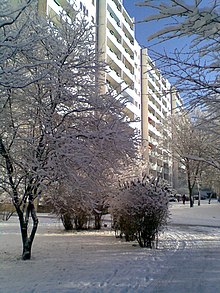WBS 70

WBS 70 is the abbreviation for the housing series 70 . It was a type of residential house in prefabricated construction used in the German Democratic Republic (GDR) . It was developed at the beginning of the 1970s by the German Building Academy and the Technical University of Dresden , among others .
development
At the 5th building conference of the Central Committee of the SED and the Council of Ministers of the GDR , the development of a "uniform construction system" was decided. In 1969 Wilfried Stallknecht and Achim Felz had carried out a study and from 1970 they developed the housing series 70 using the experience with types P1, P2 and QP . The "type P2" did not achieve the desired savings. For WBS 70, fewer components, a reduced type catalog and a uniform construction method have been standardized for all housing combinations.
A test run began on July 3, 1972, and the production of WBS 70 elements on October 7, 1972 in a newly built panel factory of the Neubrandenburg housing combination. On April 2, 1973, the assembly of the first WBS 70 house began. 1973 was the first WBS -70 block in Neubrandenburg ready for occupancy. This five-storey house has been a listed building since 1984 and is located at Koszaliner Straße 1/3/5/7 in the eastern part of Neubrandenburg . Of the approximately 1.52 million prefabricated apartments ( residential units = WE) built up to 1990, the WBS 70 type is the most widespread with a total of 644,900 residential units and a share of around 42 percent.
"Despite its standard design , the WBS 70 can be flexibly changed like no other type."
In Berlin-Hellersdorf , Hellersdorfer Straße 179, there is a museum apartment of the type WBS 70 that can be visited. The 61 square meter three-room apartment was furnished true to the original with furnishings from GDR production.
Technical details
At first, uniform benchmarks were set for the series of residential buildings in order to achieve a more efficient production of residential buildings. In the course of the application of this type there have been different changes and separate developments in individual housing combinations, also with conical and special elements for angled buildings and closing gaps.
- Load level: 6.3 tons (run as 63 kN)
- Consistent, uniform modular system with basic module: M = 100 mm and as a large grid size 12 M = 1.20 m, spacing of the system lines n × 1.20 m, with a basic grid: 6.00 m × 6.00 m
- Maximum element dimensions
- Wall elements 6.00 m × 2.80 m
- Ceiling elements 6.00 m by 3.00 m prestressed concrete and 3.60 m by 3.00 m reinforced concrete
- Building depth: 12 meters
- Floor height : 2.80 meters (WBS 70 / G: 3.30 meters)
- Number of floors: 5, 6 or 11
- Outer wall: three-layer with core insulation , two-stage sealed joint system with so-called "open joints"
- Inside bathrooms, partly inside, mostly outside kitchens. The former with hatches, the latter with a door and window
- Prefabricated sanitary room cells (wet cell) including complete equipment and tube bundle
- External staircase
In the 1980s, the building depth was increased to 14.40 meters for the WBS 70/1440 prefabricated building, so that the stairwell came back to be inside.
Main functional features
- Minimizing traffic areas in buildings and apartments in favor of living space
- Variability of the apartment sizes and occupancy density through different composition of the functional units
- Adaptation of the number of floors and the structure of the floor plans to the functional and urban development requirements through vertical and horizontal combination of the functional units.
Individual evidence
- ^ Building Academy of the GDR: Housing series 70. First introduction in VEB (B) Housing Combine Neubrandenburg, 1st edition 1974
- ↑ a b c WBS 70 - The standard plate
- ↑ Joachim Greiner: What else happened . (Reporting years 1972–1973). In: Neubrandenburger Mosaik 1975. pp. 92–96.

